Five Central Flyway Public Land Hotspots for 2020
Find ducks and geese on public land in the Central Flyway
Find ducks and geese on public land in the Central Flyway
Waterfowl hunting opportunities in the Central Flyway rival those found anywhere in North America, as millions of migrating waterfowl funnel through the region each fall. Many of those opportunities can be found on public land, including the following five Central Flyway waterfowl hunting hotpots.
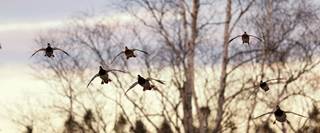
Montana may not be the first place that comes to mind when you think of waterfowl hunting, but the Big Sky State is home to thousands of acres of public hunting land, including those found on Benton Lake National Wildlife Refuge (NWR).
Located near Great Falls in central Montana, Benton Lake NWR lies along the western edge of the Central Flyway. The refuge contains just over 12,000 acres of prime waterfowl habitat, consisting of short-grass prairie and the namesake Benton Lake, which is actually a 6,000-acre shallow wetland. Locally produced mallards, pintails, gadwalls, and blue-winged teal provide the bulk of the early-season opportunities, while the region is also a stopping point later in the season for ducks and geese migrating from Canada.
In addition to roughly 2,000 acres open to hunting on the refuge, public access is also available on more than 16,000 acres of federal waterfowl production areas scattered throughout the region. There, hunters are also likely to find a mix of upland birds such as pheasants, sharp-tailed grouse, and Hungarian partridge to keep them busy after a morning on the marsh.
Dont ignore the block management areas in this region either, advises Sean Fields, coordinator of the Prairie Pothole Joint Venture based at Benton Lake NWR. There is an impressive amount of ground enrolled in this program in central Montana for both upland and waterfowl hunting.
For more information, visit fwp.mt.gov.
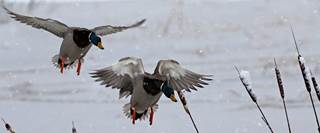
Between Garrison Dam on the Missouri River and Devils Lake to the northeast is some of the finest duck country in North Dakota, and smack in the middle of it all is Lonetree Wildlife Management Area (WMA). Managed by the North Dakota Game and Fish Department, this WMA encompasses nearly 33,000 acres of varied habitat types, including native prairie and wetlands, as well as a section of the Sheyenne River.
When youre at Lonetree, youre surrounded by some good duck country, says veteran North Dakota hunter Joe Fladeland. Go in just about any direction and youre going to find the combination of water and food that attracts local mallards, wigeon, and other ducks as well as birds migrating down from Canada.
The hunting pressure on Lonetree WMA can be heavy early in the season, so Fladeland suggests planning a trip after the first few weeks of the season.
Ducks, geese, pheasants, sharp-tailed grouse, white-tailed deereven moosethis part of the state has it all, Fladeland says.
For more information, visit gf.nd.gov.
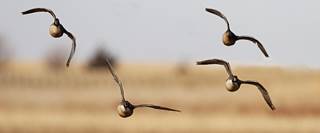
Springfield Bottoms is a section of the Missouri River along South Dakotas southeastern border that consists of cattail-lined pockets of open water scattered throughout expanses of marsh. When the weather gets cold, mallards and Canada geese flock to these waters in large numbers, providing classic waterfowl hunting in an iconic setting that is open to the public.
Larger boats are the rule for Springfield Bottoms, as is a working knowledge of the river that is notorious for log jams, sandbars, and other challenges, including the dangerous ice conditions during late-season hunts. With enough hunting pressure, birds tend to move out of the marsh and onto more open waters. Scouting then becomes an even higher priority to find pockets of remaining birds.
Later in the season this can mean waiting until after sunrise to launch your boat so you can see what the birds are doing, says veteran South Dakota hunter Phil Kahnke. And when its really cold, this also gives you a chance to get a good look at the water conditions and areas of ice.
Nonresident waterfowl hunting licenses in South Dakota are available through a lottery system. For more information, visit gfp.sd.gov.
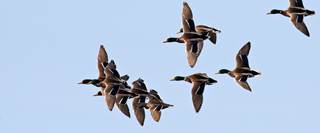
Located in Nebraskas famous Sandhills region, Valentine National Wildlife Refuge encompasses a vast expanse of rolling hills and wetlands that produce large numbers of ducks. The refuge also serves as a stopping point for migrating waterfowl, including mallards, pintails, green-winged teal, and Canada geese. This fall, hunting opportunities were expanded dramatically on the refuge, giving hunters access to an additional 25,000 acres of wetlands and uplands.
Weather is one of the biggest challenges when hunting the Sandhills, says Mark Vrtiska, waterfowl program manager for the Nebraska Game and Parks Commission, as the areas shallow wetlands freeze quickly when temperatures drop.
The other big challenge is navigating the size of the refuge and scouting to find the wetlands that the birds really want to use, Vrtiska says. There are so many options for them out there, sometimes just over the hill from where you are hunting.
If you visit this part of Nebraska, plan on bringing some good boots for walking. In addition to waterfowl hunting opportunities, Valentine NWR is one of the few places where hunters can bag both prairie chickens and sharp-tailed grouse. Pheasants are also a possibility.
For more information, visit outdoornebraska.gov.
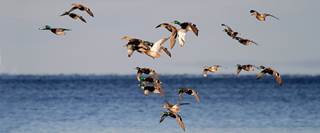
Late-season weather changes can often bring prime hunting opportunities for Kansas waterfowlers. A sweeping cold front from the north is often accompanied by a timely migration of mallards and Canada geese, while warming temperatures after a period of cold weather can bring a wave of birds up from the south. Best of all, good public hunting is available in the southeast corner of the state.
Top public hunting destinations include John Redmond, Neosho, and Marais des Cygnes Wildlife Areas, which are intensively managed by the Kansas Department of Wildlife, Parks and Tourism. Mallards, pintails, teal, and other dabblers make up the bulk of the bag.
Hunters should pay close attention to the weather before planning a trip, suggests Karl Karrow, manager of Marais des Cygnes Wildlife Area.
Just about any change in the weather is good, but we really do well when places to the north of us get some snow, Karrow says. Mallards and geese will tough it out through a good cold snap, but if their food gets covered up with snow, they tend to move south, and thats a game changer for us.
For more information about hunting on state wildlife areas, including reports on water levels and bird numbers, visit ksoutdoors.com.
Ducks Unlimited uses cookies to enhance your browsing experience, optimize site functionality, analyze traffic, and deliver personalized advertising through third parties. By continuing to use this site, you agree to our use of cookies. View Privacy Policy